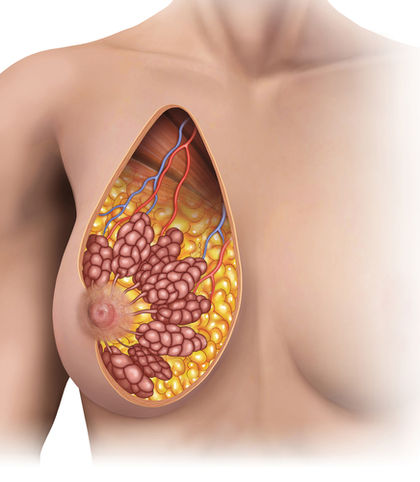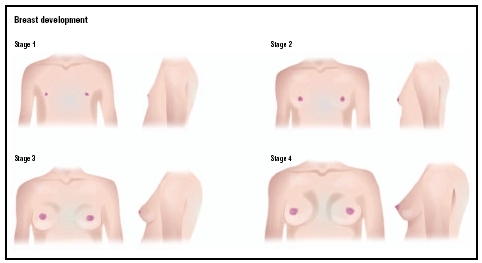Breast development

Definition
A newborn baby has nipples, areolas, and the beginnings of breast tissue, but most of breast development occurs in two different periods of time in a woman's life: first in puberty , then during pregnancy. Breast development is a vital part of puberty in the human female. Interestingly, humans are the only mammals whose breasts develop before they are needed to serve their biological purpose—breastfeeding.
Description
The first stage of breast development begins at about six weeks of fetal development with a thickening called the mammary ridge or the milk line. By six months of development, this ridge extends all the way down to the groin, but then regresses. Solid columns of cells form from each breast bud, with each column becoming a separate sweat gland. Each of these has its own separate duct leading to the nipple. By the final months of fetal development, these columns have become hollow, and by the time a female infant is born, a nipple and the beginnings of the milk-duct system have formed.
As a girl approaches puberty, the first outward signs of breast development begin to appear. When the ovaries start to secrete estrogen, fat in the connective tissue begins to accumulate causing the breasts to enlarge and the duct system begins to grow. Breast development normally begins about one to two years before the menstrual

Once ovulation and menstruation begin, the maturing of the breasts begins with the formation of secretory glands at the end of the milk ducts. The breasts and duct system continue to grow and mature with the development of many glands and lobules. The rate at which breasts grow varies significantly and is different for each young woman. Breast development occurs in five stages:
- Stage One: In preadolescence, the breasts are flat and only the tip of the nipple is raised.
- Stage Two: Buds appear, breast and nipple are raised, fat tissue begins to form and the areola (dark area of skin that surrounds the nipple) enlarges.
- Stage Three: Breasts are slightly larger with glandular breast tissue present. Initially this happens in a conical shape and later in a rounder shape. The areola begins to darken.
- Stage Four: The nipple and areola become raised and form a second mound above the rest of the breast. Menstruation typically starts within two years of reaching this stage, and some girls skip this stage completely.
- Stage Five: Mature adult breast is rounded and only the nipple is raised.
The entire process from the breast bud stage through stage five usually takes about three to five years, but for some girls it takes close to ten years. After these five stages, the breast is still not considered mature or fully developed. Only pregnancy brings about the fullness of breast growth and development.
Each month, women experience fluctuations in hormones that make up the normal menstrual cycle. Estrogen, which is produced by the ovaries in the first half of the menstrual cycle, stimulates the growth of milk ducts in the breasts. The increasing level of estrogen leads to ovulation halfway through the cycle, and then the hormone progesterone takes over in the second half of the cycle, stimulating the formation of the milk glands. These hormones are believed to be responsible for the cyclical changes such as the swelling, pain , and tenderness that many women experience in their breasts just before menstruation. Many women also experience changes in breast texture, with breasts feeling particularly lumpy. This, too, is related to the glands in the breast enlarging in preparation for a possible pregnancy. If pregnancy does not occur, the breasts return to normal size.
Common problems
Breast development can start in a girl as early as eight years or as late as 13 years. If a girl does not have breast buds or pubic hair, which is the first signs of puberty, by age 14, there may be other medical problems. Most girls begin menstruating between ages nine and 18, with an average around 12 years of age. Primary amenorrhea is the absence of any menstrual flow in a girl who has never menstruated by the age of 16. Primary amenorrhea is not considered to have occurred until a girl is beyond age 16, if she has undergone other normal changes that occur during puberty. Primary amenorrhea may occur with or without other signs of puberty, but this condition is rare in the United States occurring in only about 0.1 percent of all girls.
There are many possible causes of primary amenorrhea, including malnutrition , extreme obesity , genetic disorders, endocrine (hormonal) disorders, pituitary tumors, congenital abnormalities, anorexia nervosa , bulimia, and, of course, pregnancy. Emotional distress or crisis about being different from friends or family can occur.
Parental concerns
Parents should become concerned if their daughter shows no signs of breast development by age 14 and if by the age of 16, there has not been a menstrual period.
When to call the doctor
Parents should call their health provider if their daughter is older than 16 and has not yet begun menstruating.
KEY TERMS
Anorexia nervosa —An eating disorder marked by an unrealistic fear of weight gain, self-starvation, and distortion of body image. It most commonly occurs in adolescent females.
Bulimia nervosa —An eating disorder characterized by binge eating and inappropriate compensatory behavior, such as vomiting, misusing laxatives, or excessive exercise.
Congenital —Present at birth.
Puberty —The point in development when the ability to reproduce begins. The gonads begin to function and secondary sexual characteristics begin to appear.
See also Puberty .
Resources
BOOKS
Adams, G. R., and M. D. Berzonsky. Blackwell Handbook of Adolescence (Blackwell Handbooks of Developmental Psychology). Malden, MA: Blackwell Publishing, 2003.
Hayward, C., et al. Gender Differences at Puberty (Cambridge Studies on Child and Adolescent Health). Cambridge, MA: Harvard University Press, 2003.
Love, S., et al. Dr. Susan Love's Breast Book. New York: Perseus Book Groups, 2000.
ORGANIZATIONS
American College of Obstetricians and Gynecologists. 409 12th Street, SW, PO Box 96920, Washington, DC 20090. Web site: http://www.acog.org.
Association of Women's Health, Obstetric and Neonatal Nursing. 2000 L Street, NW, Suite 740, Washington, DC 20036. Web site: http://www.awhonn.org.
WEB SITES
"Amenorrhea-primary." MedlinePlus , May 11, 2004. Available online at http://www.nlm.nih.gov/medlineplus/ency/article/001218.htm (accessed December 7, 2004).
"Breast Health." Breast Health. Available online at http://www.ohsuhealth.com/htaz/breast/breast_health_online_resources.cfm (accessed December 7, 2004).
4Girls. Available online at http://www.4girls.gov/ (accessed December 7, 2004).
Linda K. Bennington, RNC, MSN, CNS
Comment about this article, ask questions, or add new information about this topic: